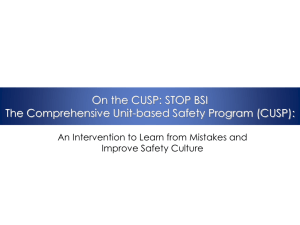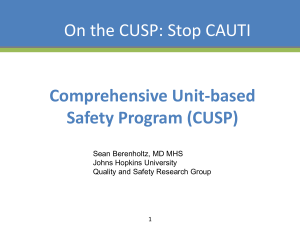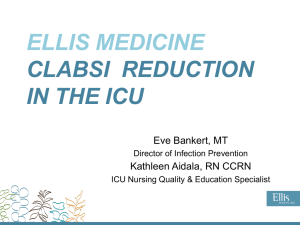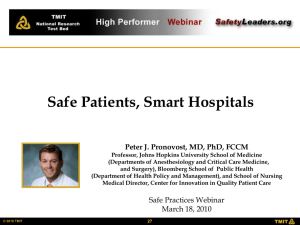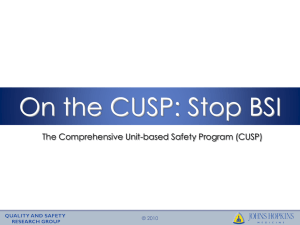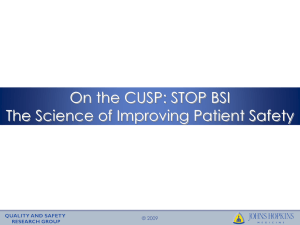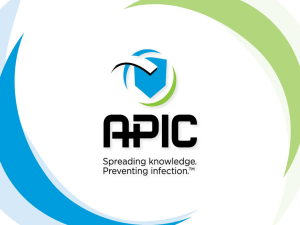Project Report - Lean Sigma - Massachusetts Coalition for the
advertisement
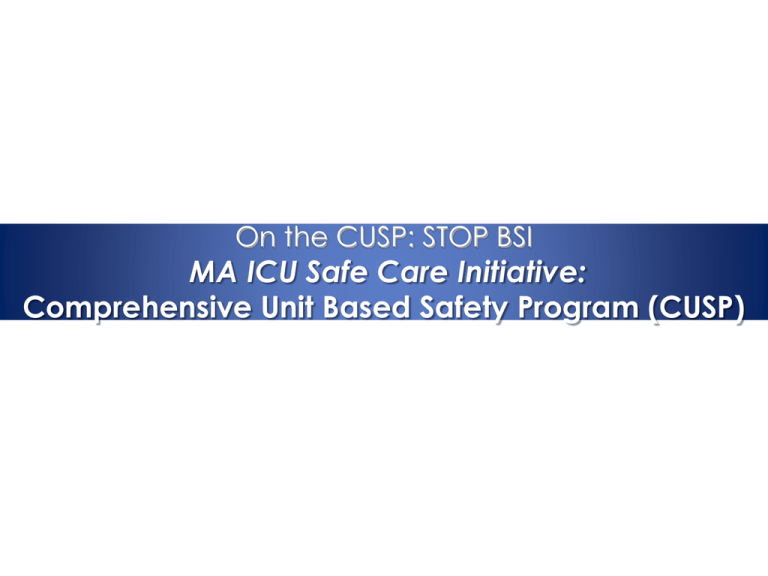
On the CUSP: STOP BSI MA ICU Safe Care Initiative: Comprehensive Unit Based Safety Program (CUSP) Objectives • Review the purpose of the ICU Comprehensive UnitBased Safety Program/CLABSI Initiative. Understand how your ICU and your hospital will benefit from participation. • Build the skills of physicians, nurses, and other care team to improve teamwork and build a safety culture. • Engage in discussion with national experts on best practices in reducing infections, preventing central line infections © 2009 Goals • Work to eliminate CLABSI • Learn from two defects per quarter – One local, one central • Improve culture by 50% © 2009 On the CUSP: Stop BSI Intervention Comprehensive Unitbased Safety Program BSI-Reduction Bundle -5 steps -Best-evidence supplies, organization of supplies -Improve/reinforce good crossdisciplinary communication and teamwork -5 Evidence-based practices -Checklist to ensure consistent application of evidence -Enhance coordination of care -Investigate all infections -Address overall patient safety -Transparency about rates -Work towards healthy unit culture -Line maintenance Learning Objectives At the end of this session you will be able to: • Explain the philosophy and approach of CUSP • Describe the steps in CUSP • Apply available teamwork tools on www.onthecuspstophai.org © 2009 Learning Objectives You will also be able to: • Describe the model for translating evidence into practice • Explain how to implement evidence-based behaviors to prevent CLABSI • Define strategies to engage, educate, execute and evaluate © 2009 The Vision of CUSP The Comprehensive Unit-based Safety Program is a cultural program designed to: – educate and improve awareness about patient safety and quality of care – empower staff to take charge and improve safety in their work place – partner units with a hospital executive to improve organizational culture and provide resources for unit improvement efforts – provide tools to investigate and learn from defects – help improve communication and teamwork © 2009 Pre CUSP Work • Create a CUSP/CLABSI team – Nurse, physician administrator, others – Assign a team leader • Measure culture in the unit • Work with hospital quality leader or hospital management to have a senior executive assigned to CUSP/CLABSI team © 2009 CUSP: 5 Steps 1. Educate staff on Science of Safety 2. Identify defects 3. Assign executive to adopt unit 4. Learn from one defect per quarter 5. Implement teamwork tools Pronovost J, Patient Safety, 2005 © 2009 Step 1: Science of Safety • Understand system determines performance • Use strategies to improve system performance – Standardize – Create independent checks for key process – Learn from mistakes • Apply strategies to both technical work and team work • Recognize teams make wise decisions with diverse and independent input • http://www.safercare.net/OTCSBSI/Staff_Training/Entries/2009 /9/6_1._The_Science_of_Improving_Patient_Safety.html © 2009 Local Examples • How Science of safety training was rolled out © 2009 Step 2: Identify Defects • Review error reports, liability claims, sentinel events or M and M conferences • Ask staff how the next patient might be harmed • List and prioritize all defects © 2009 Step 2: Identify Defects Complete the Staff Safety Assessment (Appendix C) © 2009 Staff Safety Assessment Results N=24* *2 answered unit is safe © 2009 Local Examples • How Staff Safety Assessment was done, what results were; how categorized and selected a defect to work on © 2009 Step 3: Executive Partnership • Executive should become a member of unit team • Executive should meet monthly with unit team • Executive should review defects, ensure unit team has resources to reduce risks, and hold team accountable for improving risks and central line associated blood stream infections © 2009 Local Examples • How an executive was identified, invited or assigned, type of executive; how often they visit unit, how they have been involved in the project and in prioritizing and resolving defects © 2009 Step 4: Learning from Mistakes • Select a specific defect – What happened? – Why did it happen (system lenses) ? – What could you do to reduce risk ? – How do you know risk was reduced ? • Creates early wins for the project Pronovost 2005 JCJQI © 2009 What Happened? • Reconstruct the timeline and explain what happened • Put yourself in the place of those involved, in the middle of the event as it was unfolding • Try to understand what they were thinking and the reasoning behind their actions/decisions • Try to view the world as they did when the event occurred Source: Reason, 1990; 19 © 2009 Why did it Happen? • Develop lenses to see the system (latent) factors that led to the event • Often result from production pressures • Damaging consequences may not be evident until a “triggering event” occurs Source: Reason, 1990; 20 © 2009 What will you do to reduce risk ? • Prioritize most important contributing factors and most beneficial interventions • Safe design principles – Standardize what we do − Eliminate defect – Create independent check – Make it visible • Safe design applies to technical and team work 21 © 2009 What will you do to reduce risk? • Develop list of interventions • For each Intervention rate – How well the intervention solves or reduces the problem – The team belief that the intervention will be used as intended • Select top interventions (2 to 5) and develop intervention plan – Assign person, task follow up date 22 © 2009 Rank Order of Error Reduction Strategies Forcing functions and constraints Automation and computerization Standardization and protocols Checklists and double check systems Rules and policies Education / Information Be more careful, be vigilant 23 © 2009 How do you know risks were reduced? • Did you create a policy or procedure (weak)? • Do staff know about policy or procedure? • Are staff using the procedure as intended? – Behavior observations, audits • Do staff believe risks were reduced? 24 © 2009 Summarize and Share Findings • Summarize findings – 1 page summary of 4 questions – Learning from defect figure • Share within your organizations • Share de-identified with others in collaborative (pending institutional approval) 25 © 2009 Safety Tips: Label devices that work together to complete a procedure Rule: stock together devices need to complete a task CASE IN POINT: An African American male ≥ 65 years of age was admitted to a cardiac surgical ICU in the early morning hours. The patient was status-post cardiac surgery and on dialysis at the time of the incident. Within 2 hours of admission to the ICU it was clear that the patient needed a transvenous pacing wire. The wire was Threaded using an IJ Cordis sheath, which is a stocked item in the ICU and standard for PA caths, but not the right size for a transvenous pacing wire. The sheath that matched the pacing wire was not stocked in this ICU since transvenous pacing wires are used infrequently. The wire was threaded and placed in the ventricle and staff soon realized that the sheath did not properly seal over the wire, thus introducing risk of an air embolus. Since the wire was pacing the patient at 100%, there was no possibility for removal at that time. To reduce the patient’s risk of embolus, the bedside nurse and resident sealed the sheath using gauze and tape. SYSTEM FAILURES: OPPORTUNITIES for IMPROVEMENT: Knowledge, skills & competence. Care providers lacked the knowledge needed to match a transvenous pacing wire with appropriate sized sheath. Regular training and education, even if infrequently used, of all devices and equipment. Unit Environment: availability of device. The appropriate size sheath for a transvenous pacing wire was not a stocked device. Pacing wires and matching sheathes packages separately… increases complexity. Infrequently used equipment/devices should still be stocked in the ICU. Devices that must work together to complete a procedure should be packaged together. Medical Equipment/Device. There was apparently no label or mechanism for warning the staff that the IJ Cordis sheath was too big for the transvenous pacing wire. Label wires and sheaths noting the appropriate partner for this device. ACTIONS TAKEN TO PREVENT HARM IN THIS CASE The bedside nurse taped together the correct size catheter and wire that were stored in the supply cabinet. In addition, she contacted central supply and requested that pacing wires and matching sheaths be packaged together. Identified concern from Staff Safety Assessment (CUSP Step 2) Recommended Improvements (CUSP Step 4 & 5) Interventions Implemented Risk of central line associated bloodstream infections Make sure best practices are used for all central line insertions. A line cart and checklist are used for all central line insertions. Risk of central line associated bloodstream infections due to poor compliance with IV tubing changes Make sure every central line IV tubing is changed according to best practice. New IV tubing labeling system used. Risk of medication errors Point of care pharmacist available on units Pharmacist assigned Poor management of pain Create guideline or protocol for pain assessment and management Pain card at every bedside Poor communication among providers Create Short Term (Daily) Goals Sheet Short term goals sheet used during rounds Poor communication during ICU discharge leading to medication errors in transfer orders Implement medication reconciliation process at ICU discharge Medication reconciliation done at discharge Improve Pain Management • Educate Staff • Put visual analog pain scale (VAS) card at bedside • Have residents report pain scores • Define defect as pain score > 3 Erdek Pronovost Erdek & Pronovost © 2009 Improve Pain Assessment 100 90 80 70 60 50 40 30 20 10 0 % with VAS week week week week week week week 1 2 3 4 5 6 7 © 2009 Improve Pain Management 100 90 80 70 60 50 40 30 20 10 0 % with VAS < 3 week 1 week 2 week 3 week 4 week 5 © 2009 Step 5: Teamwork Tools • Call list • Daily goals • AM briefing • Shadowing • Culture check up Pronovost JCC, JCJQI © 2009 Local Examples • Experience using some of the CUSP teamwork tools © 2009 CUSP is a Continuous Effort • CUSP is a marathon not a sprint • Add Science of Safety education to orientation • Ask staff every six months how the next patient is going to be harmed and invest the time and resources to reduce this harm • Learn from one defect per quarter, share lessons • Implement teamwork tools that best meet the unit’s needs © 2009 Safety Culture-2 CUSP ICUs Relative % Increase Pre to Post Program Questions 1. The senior leaders in my hospital listen to me and care about my concerns. 22 2. The physicians and nurse leaders in my area listen to me and care about my concerns. 30 3. My suggestions about safety would be acted upon if I expressed them to management. 30 4. Management/Leadership will never compromise safety concerns for productivity. 22 5. I am encouraged by my supervisors and coworkers to report any unsafe conditions I observe. 32 © 2009 Safety Culture- 2 CUSP ICUs Relative % Increase Before vs After Program Questions 6. I know the proper channels to report my safety concerns. 30 7. I am satisfied with availability of clinical leadership (MD, RN, RPh). 44 8. Leadership is driving us to be a safety-centered institution. 35 9. I am aware that patient safety has become a major area for improvement in my institution. 30 10. I believe that most adverse events occur as a result of multiple system failures, and are not attributable to one individual’s actions. 34 © 2009 Eliminating CLABSI Pronovost, Berenholtz, Needham BMJ 2008 Evidence-based Behaviors to Prevent CLABSI • Remove Unnecessary Lines • Wash Hands Prior to Procedure • Use Maximal Barrier Precautions • Clean Skin with Chlorhexidine • Avoid Femoral Lines MMWR. 2002; 51:RR-10 © 2009 Identify Barriers • Ask staff about knowledge • Ask staff what is difficult about doing these behaviors • Walk the process of staff placing a central line • Observe staff placing central line • Observe present maintenance procedures © 2009 Ensure patients reliably receive the interventions: the 4Es • Engage: stories, show baseline data • Educate staff on evidence • Execute – – – – – Standardize: Create line cart Create independent checks: Create BSI checklist Empower nurses to stop takeoff Use line maintenance protocol Learn from mistakes: review infections • Evaluate – Feed back performance – Audit line maintenance – View infections as defects © 2009 Partnership • To help with 4Es, partner with − Infection control staff − Hospital quality and safety leaders − Nurse educators − Physician leaders ICU staff must assume responsibility for reducing CLABSI © 2009 Engage • Share about a patient who was infected • Share stories about when nurses ensured patients received the evidence • Post baseline rates of infections • Estimate number of deaths and dollars from current infection rates (see opportunity calculator) • Remind staff that most CLABSI are preventable © 2009 Educate • Conduct in-service regarding CLABSI prevention • Create forum to jointly educate physicians and nurses • Add CLABSI prevention to ICU orientation • Give staff fact sheet, articles and slides of evidence © 2009 Local Examples • Engagement or development of communication plan © 2009 Execute • Standardize: Create line cart • Create independent checks: Create BSI checklist • Empower nurses to ensure physicians comply with checklist – Nurses can stop takeoff • Learn from mistakes: review every infection using learning from defect tool • Use recommended practices for line maintenance © 2009 Local Examples • Checklist modification • Cart or kit creation, stocking, accountability plan • How to get line removal evaluated and get lines out in timely fashion © 2009 Evaluate • Monitor rates of infections using the Centers for Disease Control Definitions • Post in the unit rates of infections per quarter (X axis is time) • Post number of weeks or months without an infection • Audit line maintenance procedures © 2009 Local examples • Unexpected infections; investigating an infection; re-education efforts; sustainability planning © 2009 Adventist Quarterly CLABSIs per 1000 line days Intervention 1 (n=23) Baseline (2006) Mar 07 1st Q (Apr-Jun 07) 2nd Q (Jul-Sep 07) 3rd Q (Oct-Dec 07) 4th Q (Jan-Mar 08) 5th Q (Apr-Jun 08) 6th Q (Jul-Sep 08) BSI rate reduction from baseline to 6th quarter BSI rate 4.48 4.71 1.12 1.83 1.33 0.96 0.88 0.85 IRR % of reduction 1.00 1.05 5% 0.25 -80% 0.41 16% 0.30 -11% 0.21 -8% 0.20 -2% 0.19 -1% BSI rate 2.71 2.16 0.56 0.52 0.83 -81% Unpublished data—Not for circulation April 8, 2015 Intervention 2 (n=22) IRR 1.00 0.79 0.21 0.19 0.31 % of reduction -21% -59% -2% 12% -69% 49 Action Plan-New Teams • Meet with unit team, infection control staff, quality and safety leaders, nurse educators and physician champions • Understand barriers (walk the process) • Use 4Es grid to develop strategy to engage, educate, execute and evaluate • Make weekly task list © 2009 Action Plan-New Teams • Look over the CUSP manual with team members • Brainstorm potential hazards with team • Assess team composition with respect to CUSP elements © 2009 Action Plan—Old Teams • Revisit the CUSP program--Try something you haven’t tried yet • Continue to learn from a defect at least once a quarter—go for two! • Consider applying your knowledge to new issues: EXAMPLES: VAP prevention Sepsis identification and management Intra-abdominal hypertension identification and management – Delirium and Progressive mobility – – – – © 2009 References • Pronovost P, Weast B, Rosenstein B, et al. Implementing and validating a comprehensive unit-based safety program. J Pat Safety. 2005; 1(1):33-40. • Pronovost P, Berenholtz S, Dorman T, Lipsett PA, Simmonds T, Haraden C. Improving communication in the ICU using daily goals. J Crit Care. 2003; 18(2):71-75. • Pronovost PJ, Weast B, Bishop K, et al. Senior executive adopt-a-work unit: A model for safety improvement. Jt Comm J Qual Saf. 2004; 30(2):59-68. • Thompson DA, Holzmueller CG, Cafeo CL, Sexton JB, Pronovost PJ. A morning briefing: Setting the stage for a clinically and operationally good day. Jt Comm J Qual and Saf. 2005; 31(8):476-479. © 2009 References • Pronovost PJ, Needham D, et al. An intervention to decrease catheter-related bloodstream infections in the ICU. New Eng J Med 2006 355(26):2725-32. • Gawande A. The checklist. The New Yorker 2007 Dec. Annals of Medicine section. • Pronovost PJ, Berenholtz SM, et al. Improving patient safety in intensive care units in Michigan. J Crit Care 2008 23(2):207-21. • Pronovost PJ, Holzmueller CG, et al. A practical tool to learn from defects in patient care. Jt Comm J Qual and Saf 2006 32(2):102-8. • Lubomski LH, Marstellar JA, Hsu Y, Boeschel CA, Holzmueller CG, Pronovost PJ. The team checkup tool: Evaluating QI team activities and giving feedback to senior leaders. Jt Comm J Qual and Pat Saf 2008 34(10):619-23. • Goeschel CA, Pronovost PJ. Harnessing the potential of healthcare collaboratives: Lessons from the Keystone ICU project. AHRQ Advances in Patient Safety: New Directions and Alternative Approaches, in press. © 2009 Objectives • Review the purpose of the ICU Comprehensive UnitBased Safety Program/CLABSI Initiative. Understand how your ICU and your hospital will benefit from participation. • Build the skills of physicians, nurses, and other care team to improve teamwork and build a safety culture. • Engage in discussion with national experts on best practices in reducing infections, preventing central line infections © 2009

